24 Customizable Templates for Easy Termination: Residency Termination Letters for Landlords and Tenants
Residency Termination Letters is your ultimate resource for professionally crafted termination letter templates. Whether you are a landlord, property manager, or tenant, we understand the complexities and sensitivities that come with terminating a tenancy. Our platform is designed to simplify this process by offering a diverse range of customizable letters, tailored to various termination scenarios. With a strong emphasis on clear communication, legal compliance, and maintaining positive relationships, our goal is to ensure a smooth and amicable termination experience for everyone involved. Let us be your trusted guide as we navigate the intricacies of residency termination, facilitating a fair and respectful transition for all parties.
How to Use the Letters
Using the termination letters effectively is essential to ensure clear communication and proper handling of the termination process. Here are some guidance and tips on how to use the letters:
- Choose the Right Letter: Select the termination letter that best matches the specific situation you are dealing with. Each letter is designed for different scenarios, such as lease non-renewals, eviction due to violations, mutual agreements, and more.
- Personalize the Letter: Customize the letter by including the tenant’s name, address, and any relevant details about the property and lease agreement. This personal touch shows professionalism and indicates that the letter is specifically meant for the recipient.
- Be Clear and Specific: Clearly state the reasons for the termination in the letter. Provide specific details, such as the violation committed, the non-renewal decision, or the mutual agreement terms. Avoid ambiguous language and ensure all relevant information is included.
- Check Local Laws: Before sending the letter, ensure it complies with local laws and regulations. Termination requirements may vary by region, so familiarize yourself with the legal obligations for issuing termination notices in your area.
- Proper Notice Period: Respect the required notice period as per local laws or the terms of the lease agreement. The notice period may differ depending on the reason for termination and local regulations.
- Keep a Record: Maintain a copy of the termination letter and any supporting documentation, such as evidence of lease violations or mutual agreements. This documentation can be crucial in case of disputes or legal issues.
- Consider Delivery Method: Choose a delivery method that provides proof of receipt, such as certified mail or email with a read receipt. This ensures that the tenant receives the letter and avoids potential disputes over its delivery.
- Maintain Professionalism: Keep the tone of the letter professional and respectful, even if the termination is due to violations or non-compliance. Avoid using offensive language and focus on the facts.
- Offer Assistance: If possible, provide contact information or resources to help the tenant with their transition. This gesture can demonstrate empathy and may ease the process for both parties.
- Document Communications: Keep a record of any communication with the tenant related to the termination. This includes emails, phone calls, or in-person conversations. Documenting these interactions can be valuable in case of disputes.
Importance of Clear Communication
Clear and respectful communication is the cornerstone of a successful and amicable termination process when it comes to ending a tenancy. Maintaining positive relationships with tenants during this sensitive time is crucial for both parties involved. Here are some insights and points to consider:
- 1. Empathy and Understanding: Show empathy and understanding when communicating the termination to tenants. Acknowledge that this is a challenging situation for them and demonstrate compassion.
- 2. Early Communication: Inform tenants about the possibility of termination as early as possible. Timely communication allows them to make informed decisions and plan for the future.
- 3. Open Dialogue: Encourage open dialogue with tenants. Listen to their concerns and be responsive to any questions they may have. Clear up any uncertainties to avoid misunderstandings.
- 4. Transparency: Be transparent about the reasons for termination. Clearly state the specific violations or non-renewal reasons, providing evidence if necessary. Transparency builds trust and reduces potential conflicts.
- 5. Offer Alternatives: If appropriate, consider discussing alternative solutions with the tenant. This may include offering them a chance to rectify lease violations or suggesting other available rental options.
- 6. Compliance with Legal Requirements: Ensure that the termination process adheres to local laws and regulations. Failure to comply with legal requirements may lead to disputes and legal consequences.
- 7. Written Documentation: Use written documentation to communicate the termination formally. Provide tenants with a written notice and retain copies for your records.
- 8. Language and Tone: Use professional language and a respectful tone in all communications. Avoid confrontational or aggressive language that may escalate tensions.
- 9. Respect Privacy: Respect the tenant’s privacy during the termination process. Avoid discussing their situation with other tenants or third parties.
- 10. Provide Ample Notice: Give tenants sufficient notice period as required by law or the terms of the lease. Ample notice allows tenants to make appropriate arrangements and avoid feeling rushed.
- 11. Be Prepared to Assist: Be prepared to offer assistance and guidance to the tenant during their transition. This may include providing resources for finding new housing or referring them to relevant support services.
- 12. Final Walkthrough: Conduct a final walk-through with the tenant to address any remaining concerns and to finalize the termination process.
#1: Formal Residency Termination Notice
The Formal Residency Termination Notice is like a letter that landlords or property managers use to tell tenants that their lease agreement is coming to an end. It’s a formal way of saying, “Hey, you gotta move out by this date.” This letter can be used for different reasons, like if a tenant isn’t playing by the rules, if the lease is not getting renewed, or for any other stuff that means it’s time to say goodbye to the place. It’s an official paper that gives tenants enough time to find a new spot and get their stuff together. The main idea is to make sure everyone’s on the same page and follows the rules, so there won’t be any big issues or fights later on.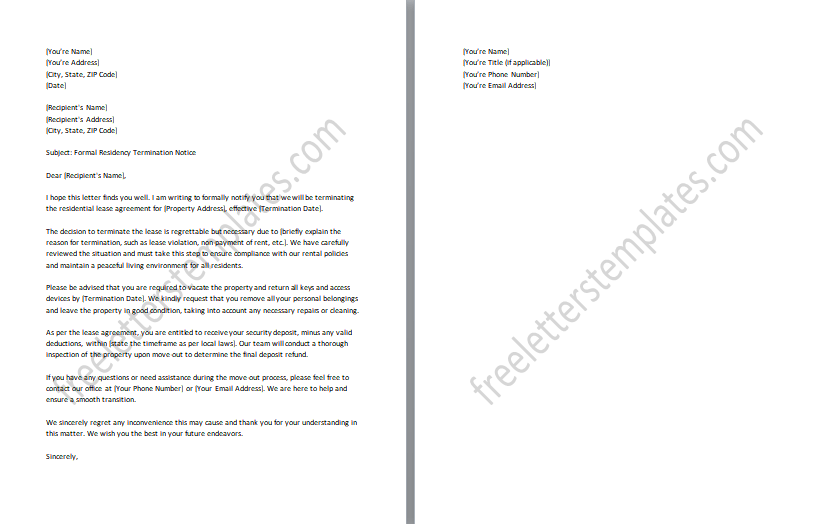
#2: Non-Renewal of Residency Agreement
The Non-Renewal of Residency Agreement is a letter that landlords or property managers use to tell tenants that their current lease won’t be renewed when it comes to an end. It’s like a formal way of saying, “Hey, we won’t be extending your stay here.” This letter is used when the landlord decides not to offer a lease extension for different reasons, like maybe they have other plans for the property, or they want to do some renovations, or they’re changing their rental policies. The main idea is to give tenants enough time to figure out where they’re going next and plan for moving out. It’s all about keeping the communication clear and making sure both the tenants and the landlord have a smooth transition.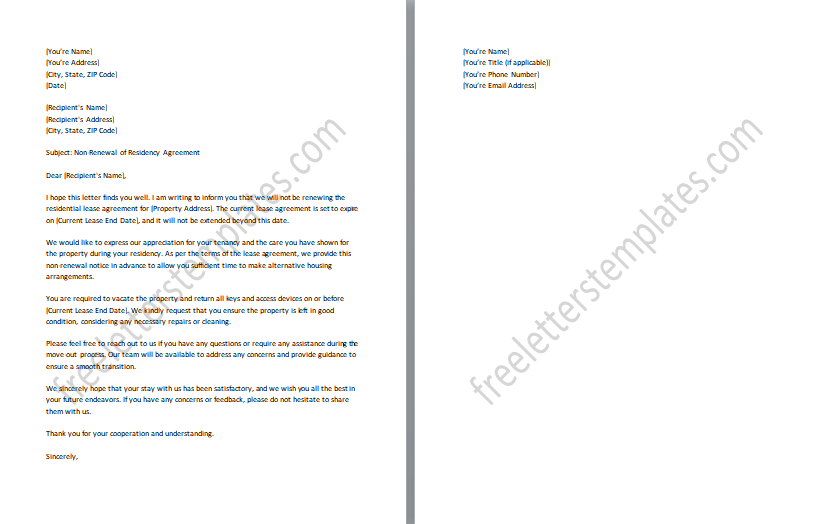
#3: Lease Violation Termination Letter
The Lease Violation Termination Letter is a letter that landlords or property managers use to let tenants know that their lease agreement is being terminated because they broke the rules. It’s like an official notice saying, “Hey, we can’t keep you here anymore because you haven’t been following the lease terms.” This letter is used when the tenant has been doing things like causing trouble, doing illegal stuff, or not taking care of the property as they’re supposed to. The main idea is to make it clear why the lease is getting terminated and to give the tenant enough time to move out. It’s all about making sure everyone follows the rules and that the property stays safe and well-maintained for everyone else.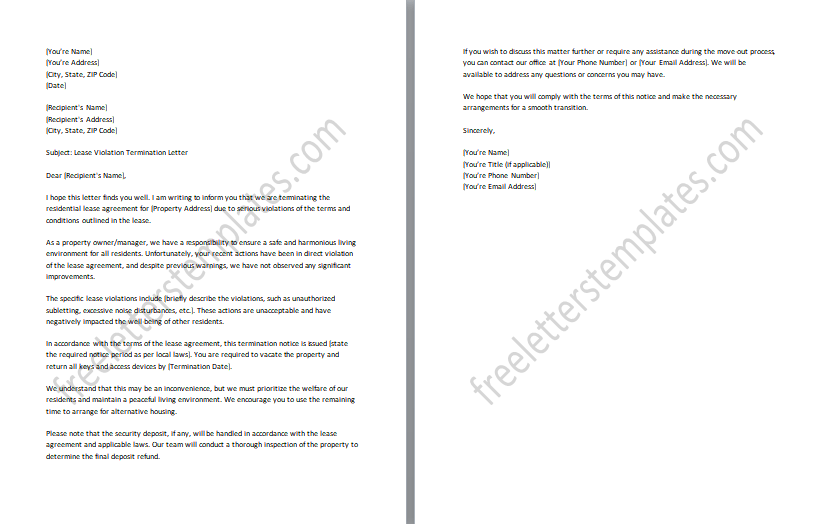
#4: Eviction Notice for Lease Non-Compliance
The Eviction Notice for Lease Non-Compliance is a serious letter that landlords or property managers use to let tenants know they’re being evicted because they haven’t been following the lease rules. It’s like a last warning saying, “We can’t keep you here if you keep breaking the lease terms.” This letter is used when the tenant has been consistently doing things like not paying rent, causing trouble, or doing illegal stuff. The main goal is to tell the tenant that their tenancy is getting terminated, and they have to move out within a specific time. It’s a legal step taken to deal with non-compliance and make sure the property stays safe and peaceful for everyone living there.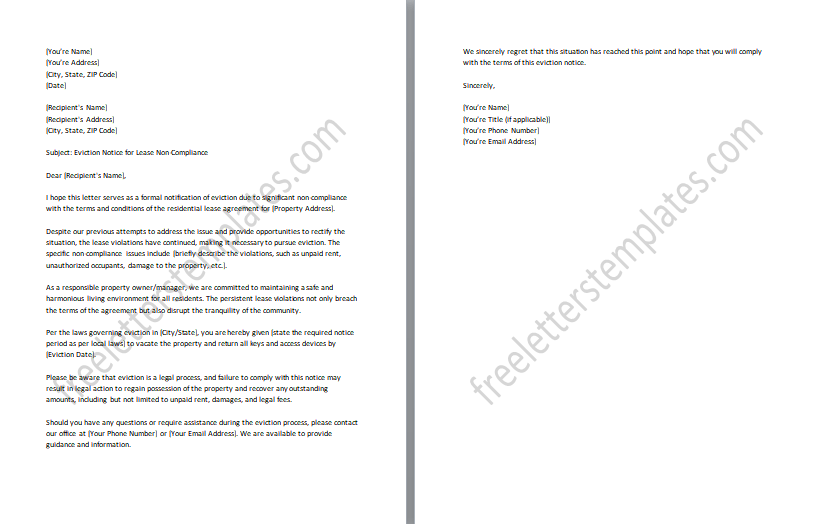
#5: Termination of Lease upon Expiry
The Termination of Lease upon Expiry is a letter that landlords or property managers use to give tenants a heads-up that their lease agreement is about to end. It’s like a friendly notice saying, “Hey, your lease is almost up.” This letter is used when the lease term is coming to its natural end, and there’s no plan to renew or extend the tenancy. The main idea is to give tenants enough time to figure out what they want to do next and get ready for moving out smoothly. It’s all about keeping the communication open and making sure both the tenants and the landlord have a good transition.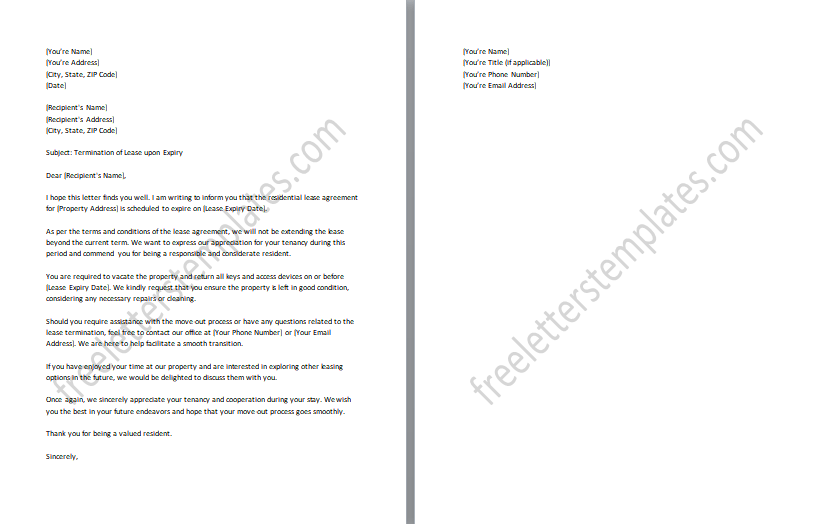
#6: Abandonment Residency Termination Letter
The Abandonment Residency Termination Letter is like a notice that landlords or property managers use to let tenants know their lease agreement is getting terminated because they’ve been away from the property for a long time without any word. It’s like saying, “Hey, we noticed you’ve left the place empty for quite a while.” This letter is used when the tenant has been gone from the property for a long time without telling anyone or showing any intention to come back. The main idea is to tell the tenant that their tenancy is getting terminated due to abandonment, and they have to move out within a certain time. It’s all about dealing with an empty property and making sure the landlord can take back control for future use or find new tenants.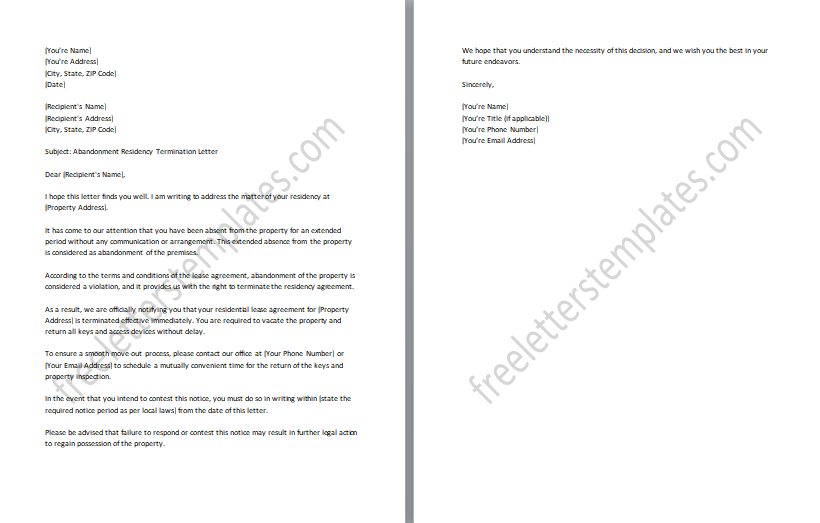
#7: Mutual Residency Termination Agreement
The Mutual Residency Termination Agreement is like a letter where both tenants and landlords agree to end the lease together. It’s like saying, “Hey, let’s end this lease.” It’s used when both parties decide it’s best to terminate the tenancy, maybe because of changes in their situation or agreed-upon terms. The main purpose is to have a smooth and friendly end to the tenancy, with everyone agreeing on when to move out. It’s all about good communication and cooperation between the tenant and the landlord.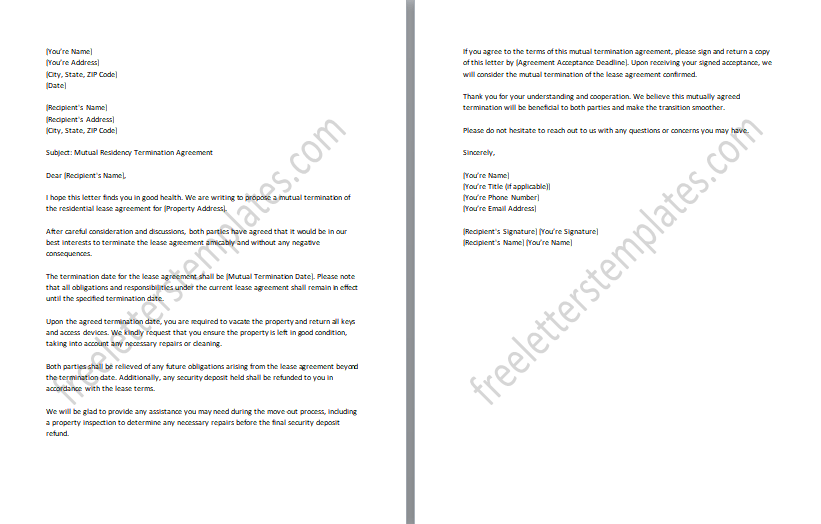
#8: Noise Complaint Termination Notice
The Noise Complaint Termination Notice is a letter that landlords or property managers use to tell tenants that their lease agreement is being terminated because of all the noise complaints we’ve received. It’s like an official way of saying, “Hey, we need to address these noise issues.” This letter comes into play when the noise from a tenant has become a constant problem, disturbing other residents and affecting their peaceful living. The main idea is to deal with these noise complaints seriously and let the tenant know that their tenancy is being terminated because of disruptive behavior. We want to make sure everyone can live harmoniously, so we’re enforcing the lease rules about noise restrictions. The letter gives the tenant a specific time to find a new place to live while aiming to maintain a peaceful and respectful community for all residents.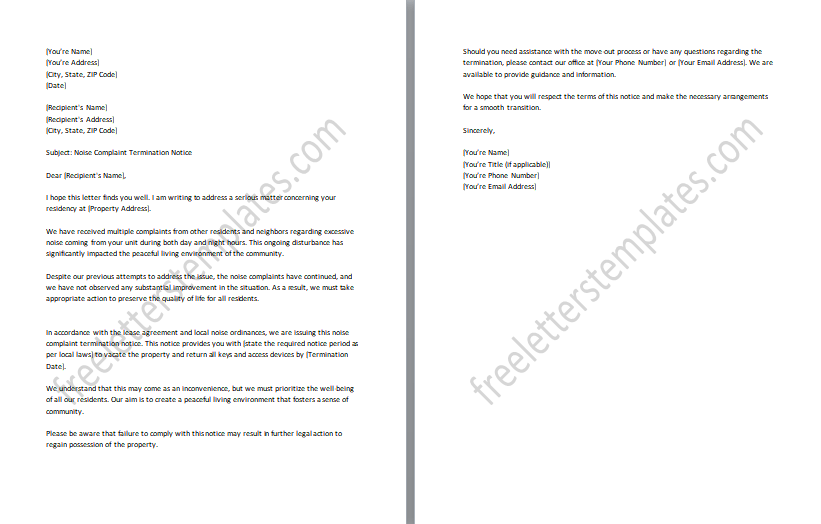
#9: Health and Safety Violation Eviction Letter
The Health and Safety Violation Eviction Letter is a formal communication issued by a landlord to a tenant who has violated health and safety regulations within the rental property. The letter serves as a warning, highlighting the specific violations and providing a reasonable timeframe for the tenant to rectify the issues. Failure to address the violations within the stipulated period may result in eviction proceedings, emphasizing the importance of ensuring a safe and habitable living environment for all occupants.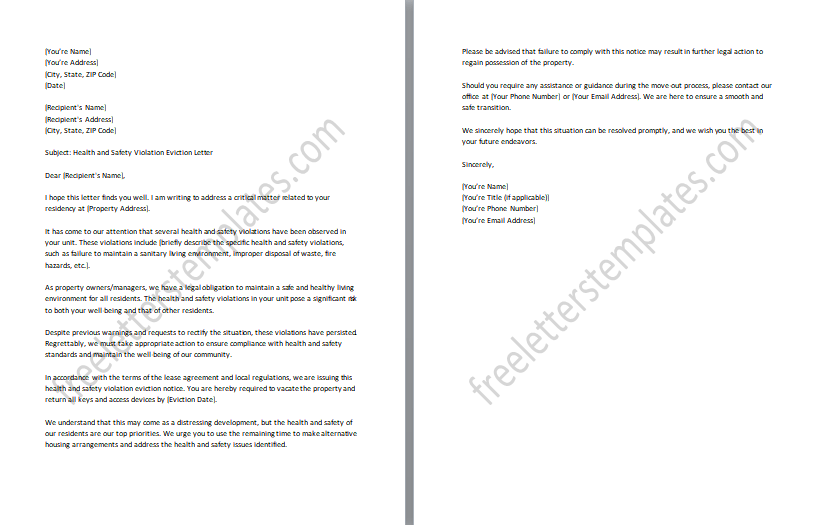
#10: Termination due to Illegal Activities
Termination due to Illegal Activities is when an employer decides to let go of an employee who has been involved in doing things that are against the law. These activities could be anything from stealing and fraud to substance abuse, harassment, or other criminal behaviors. Before the employer takes this big step of firing the employee, they need to do a proper investigation and gather evidence to be sure of the wrongdoing. The main goal here is to protect the company’s reputation and make sure everyone feels safe at work, while also following the rules and laws. This tough decision is taken to look out for the best interests of the organization and its employees. By dealing with such misconduct swiftly, the company wants to prevent any potential harm, promote a positive work culture, and discourage others from doing illegal things.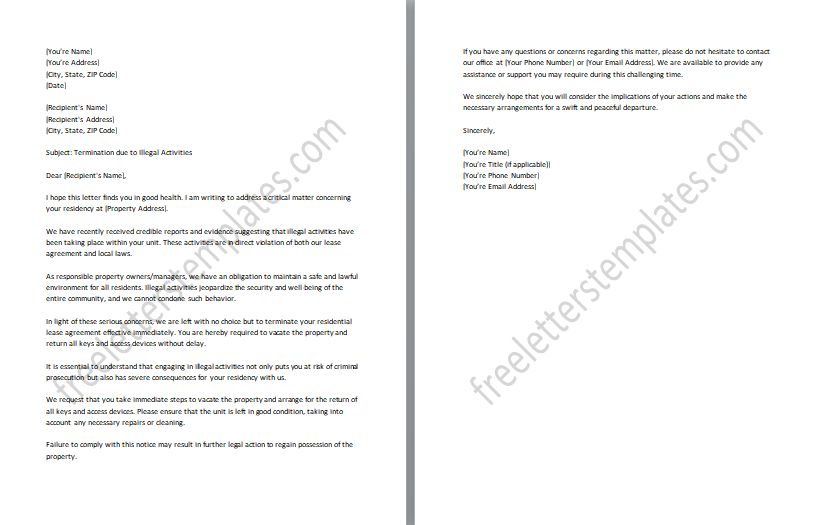
#11: Late Payment Residency Termination Letter
The Late Payment Residency Termination Letter is a formal notice issued by a landlord to a tenant who has consistently failed to pay their rent on time. The letter serves as a final warning, addressing the recurring issue of late payments and notifying the tenant of the impending termination of their residency. The landlord typically sets a specific deadline for the tenant to settle any outstanding dues and rectify the payment delays. Should the tenant fail to comply within the given timeframe, the termination of their lease agreement may proceed. The purpose of this letter is to emphasize the importance of timely rent payments and to uphold the terms and conditions of the tenancy agreement, ensuring a fair and respectful relationship between the landlord and tenant.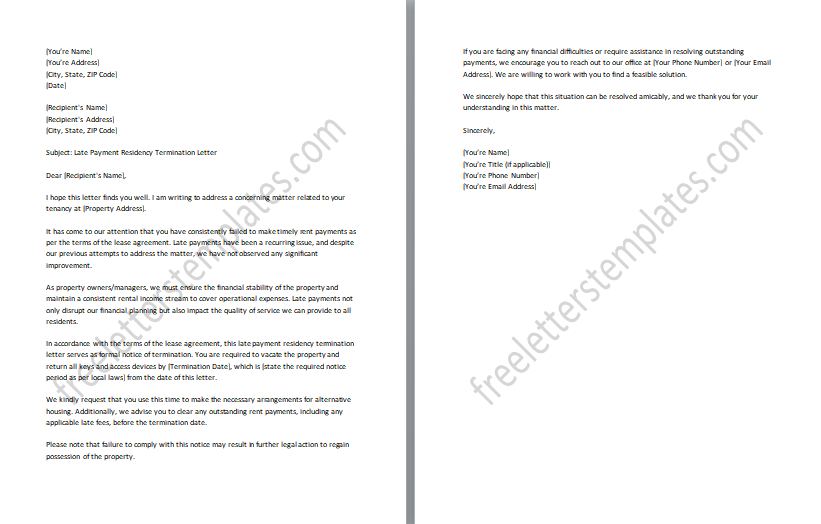
#12: Property Damage Lease Termination Notice
The Property Damage Lease Termination Notice is a friendly communication from the landlord to the tenant, addressing damage caused to the rental property. The letter informs the tenant about the damages observed and emphasizes the importance of maintaining the property during their tenancy. It explains the specific damages and offers a chance to rectify the issues promptly. The goal is to foster open communication and encourage the tenant to be mindful of their responsibilities. By working together to address the damages, the landlord aims to maintain a positive relationship while ensuring the property remains well-maintained for future occupants.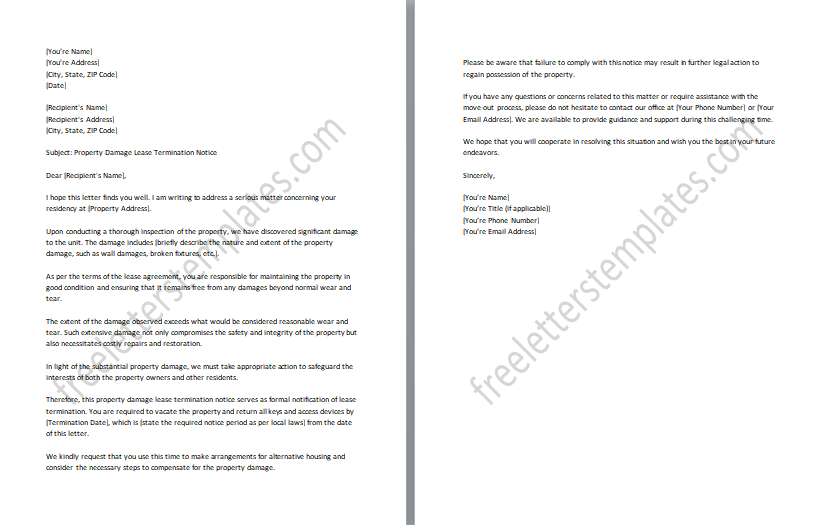
#13: Subletting Violation Eviction Letter
The Subletting Violation Eviction Letter is an important notice sent by the landlord to a tenant who might have unintentionally or knowingly sublet the rental property without getting proper permission. We just want to make sure everyone is on the same page, so we’re addressing this matter openly and clearly. We want to work together to sort things out, and that’s why we’re giving you a specific timeframe to correct the situation by discontinuing the unauthorized subletting. Our main goal is to ensure that the lease agreement is respected and that everyone’s rights are protected. We value our relationship with you and hope that we can resolve this issue amicably, but please understand that failure to comply within the given period might lead to eviction proceedings. Let’s work together to maintain a positive and respectful tenancy.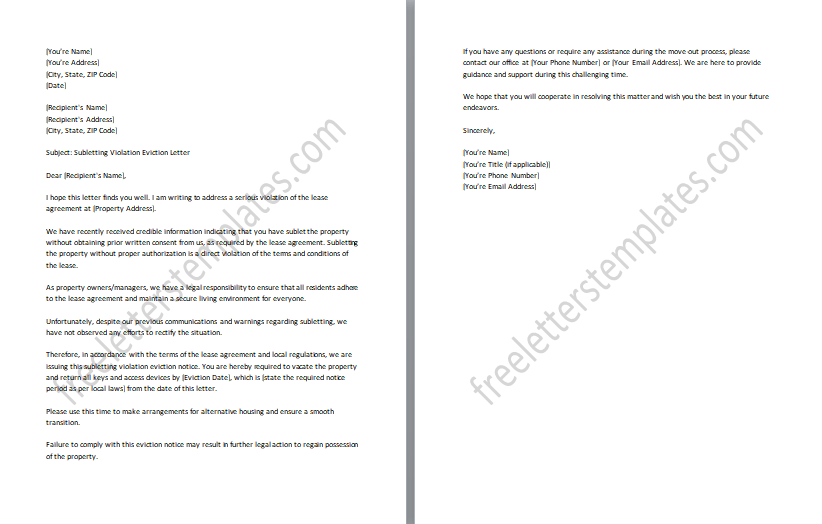
#14: Termination due to Change in Property Use
Termination due to Change in Property Use refers to the situation where a landlord decides to end a tenant’s lease agreement because they intend to use the property for a different purpose. This can happen when the landlord plans to sell the property, convert it for personal use, or engage in significant renovations that would disrupt the tenant’s occupancy. In such cases, the landlord provides the tenant with proper notice as per local laws and the terms of the lease agreement. The objective is to inform the tenant about the upcoming changes and allow them ample time to find alternative accommodation. While it may be an unfortunate circumstance, the termination is conducted to facilitate the landlord’s legitimate intentions and to ensure transparency and fairness for both parties involved.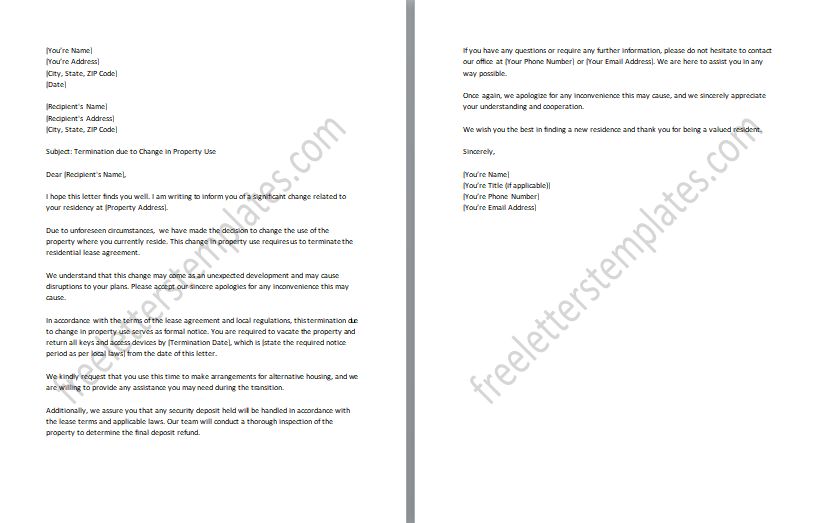
#15: Owner Move-in Residency Notice
The Owner Move-in Residency Notice is a letter from the landlord to the tenant. The landlord plans to move into the rental property. They follow rules and laws and give proper notice. The notice tells the tenant about the upcoming change. It may end the tenant’s lease. The letter includes the move-in date and lease termination details. It also mentions the security deposit. The landlord aims to be fair and transparent. The tenant gets enough time to find a new place to live. It’s not easy news, but the landlord is doing things right, considering their needs and the tenant’s best interests.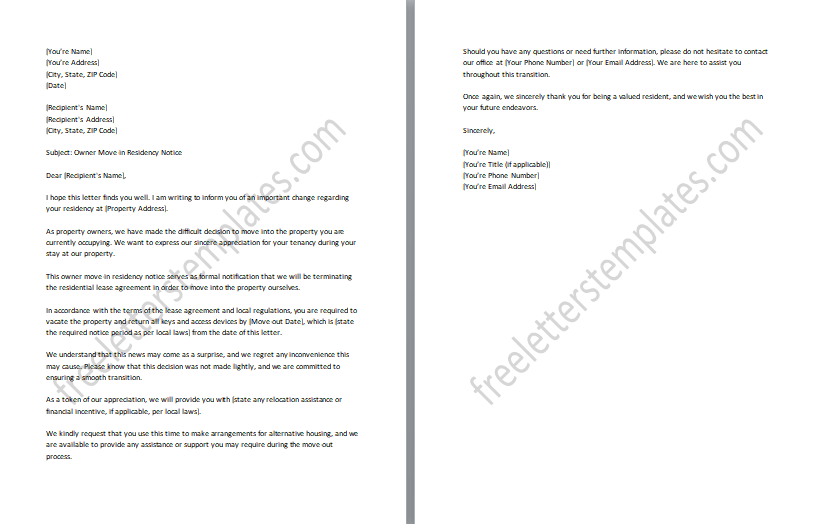
#16: Family Member Move-in Termination
The Family Member Move-in Termination is a formal notice issued by a landlord to a tenant, informing them of the landlord’s decision to terminate the lease to allow a family member to move into the rental property. The notice is typically provided in compliance with local laws and the terms of the lease agreement. Its purpose is to inform the tenant about the change in occupancy and the need for the tenant to vacate the property by a specific date. While this news might be disappointing for the tenant, the termination is executed to accommodate the needs of the landlord’s family members. The notice strives to be transparent, offering the tenant sufficient time to make necessary arrangements and find alternative housing arrangements while ensuring the landlord adheres to legal requirements and maintains a fair and respectful relationship with the tenant.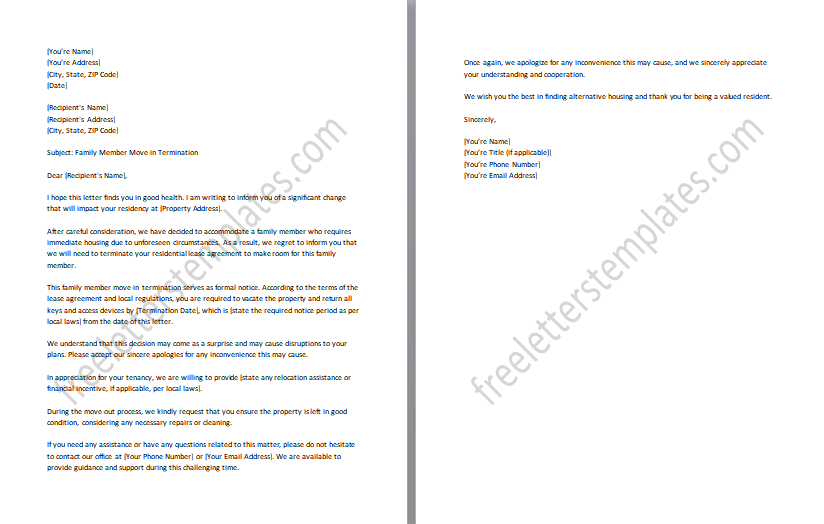
#17: Termination for Property Development/Renovation
Termination for Property Development/Renovation is a formal notice sent by a landlord to a tenant, informing them of the termination of their lease agreement due to planned property development or significant renovations. The notice is typically given by local laws and the lease terms. Its purpose is to notify the tenant about the upcoming property development or renovation project, which may require them to vacate the premises by a specific date. Although this news may be disruptive for the tenant, the termination is necessary to facilitate the planned improvements to the property. The notice aims to be transparent, providing the tenant with ample time to make alternative housing arrangements while ensuring the landlord adheres to legal requirements and maintains a fair and respectful relationship with the tenant.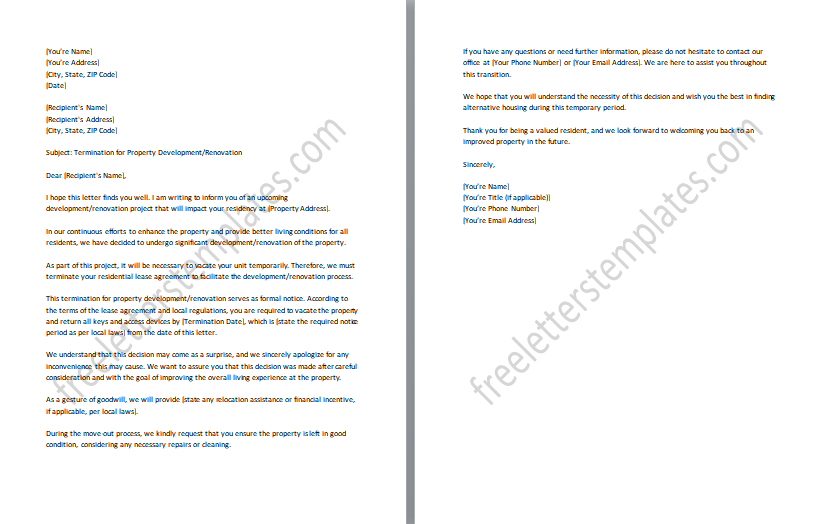
#18: Residency Termination due to Foreclosure
Residency Termination due to Foreclosure is an official notice that the landlord has to send to the tenant when things get a bit complicated with the property. You see, sometimes the rental property goes into foreclosure, which means that the ownership changes hands, and the new owner or lender might not want to keep the current lease going. It’s not something the landlord can control, and it’s not an easy situation for anyone involved. The notice is given following the rules and laws, and it gives the tenant enough time to find a new place to live. It’s tough news to receive, but the landlord wants to be honest and open about what’s happening and make sure they’re doing things the right way while treating the tenant with respect and fairness.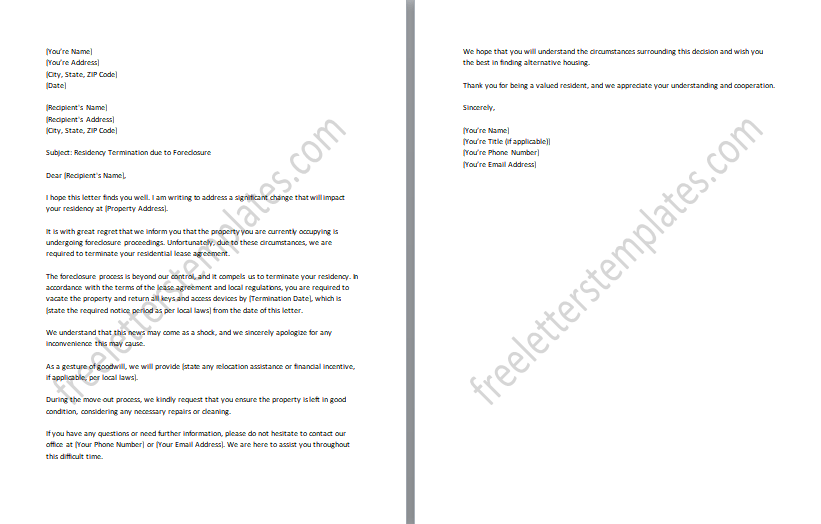
#19: Residency Termination upon Property Sale
Residency Termination upon Property Sale is something that the landlord has to do when they decide to sell the place you’re renting. It’s not always an easy choice for them, but sometimes they have their reasons for it. When the property gets sold, the new owner might have different plans, and that could mean your current lease will come to an end. The landlord has to follow the rules and regulations, so they’ll give you an official notice about what’s happening. They want to be honest with you and let you know in advance, so you have enough time to find a new place to call home. It’s not the best news to hear, but the landlord wants to handle things fairly and respectfully while keeping everything legal.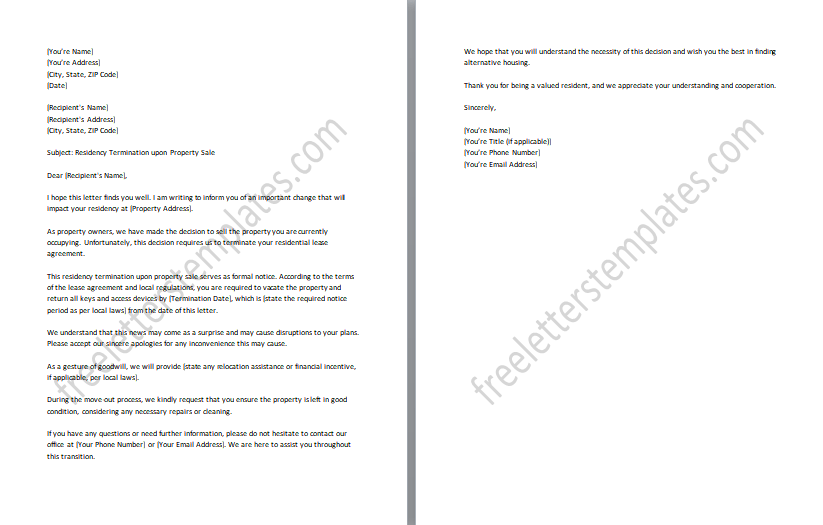
#20: University Term Residency Closure Notice
Due to unforeseen circumstances and in compliance with safety regulations, the university has issued a closure notice for on-campus residences during the current term. Students residing in university accommodation are required to vacate their rooms within a specified timeframe. The decision has been made to prioritize the well-being and health of all students, and alternative arrangements are being provided for those who may face challenges in finding suitable accommodations off-campus. Further updates and support will be communicated through official channels to ensure a smooth transition during this period.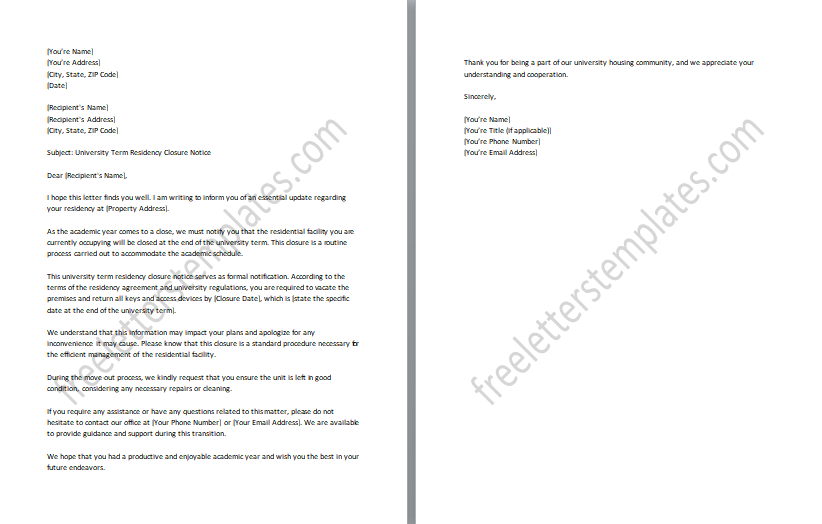
#21: Retirement Home Transfer Termination
The Retirement Home Transfer Termination letter is like a friendly notice given to residents of a retirement home, informing them about a planned transfer to another facility. It’s a way of saying, “Hey, we’ve made arrangements for you to move to a different retirement home.” This letter is used when the current facility believes that another place can better meet the residents’ needs or provide specialized care. The main goal is to make sure residents have enough time to adjust and get ready for the move, ensuring a smooth and comfortable transition. The letter emphasizes clear communication and compassionate handling of the process, putting the residents’ well-being first and aiming for a positive experience throughout the relocation.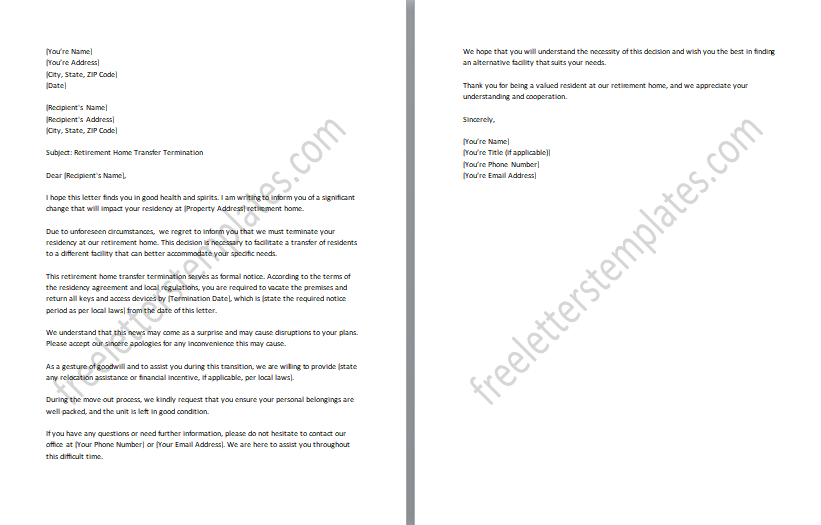
#22: Termination following Natural Disaster
The Termination following Natural Disaster is a letter landlords or managers use. It lets tenants know their lease agreement is ending due to damage from a natural disaster. It’s like saying, “Hey, the property isn’t safe anymore.” This letter is used after events like floods, earthquakes, or hurricanes. It damages the property so it’s unsafe to live there. The main goal is tenant safety and well-being. It says the tenancy is ending because of this unfortunate event. The letter gives a specific time to move out safely. So, tenants can find another place to live. We’re here to support and communicate throughout this tough time. We’ll make sure everyone follows safety regulations.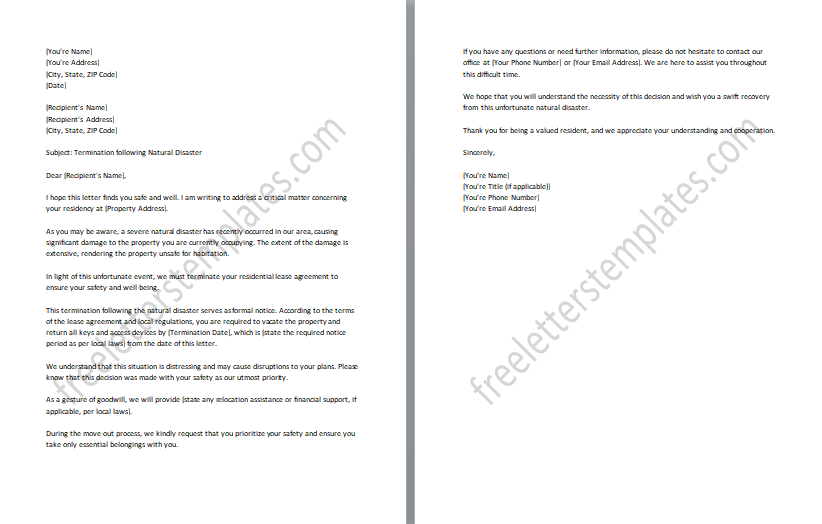
#23: Residency Termination due to Immigration Status
The Residency Termination due to Immigration Status is a letter that landlords or property managers use to let tenants know their lease agreement is being terminated because of their immigration status. It’s like an official way of saying, “Hey, your residency isn’t allowed here.” This letter is used when the tenant’s current immigration status doesn’t allow them to stay in the country or the specific area. The main idea is to follow the law and immigration regulations. The letter tells the tenant that their tenancy is getting terminated because of their immigration status. They’ll need to move out within a specific time. It’s all about handling the situation respectfully and making sure everyone follows immigration laws. The goal is to keep a fair and legal housing environment for everyone.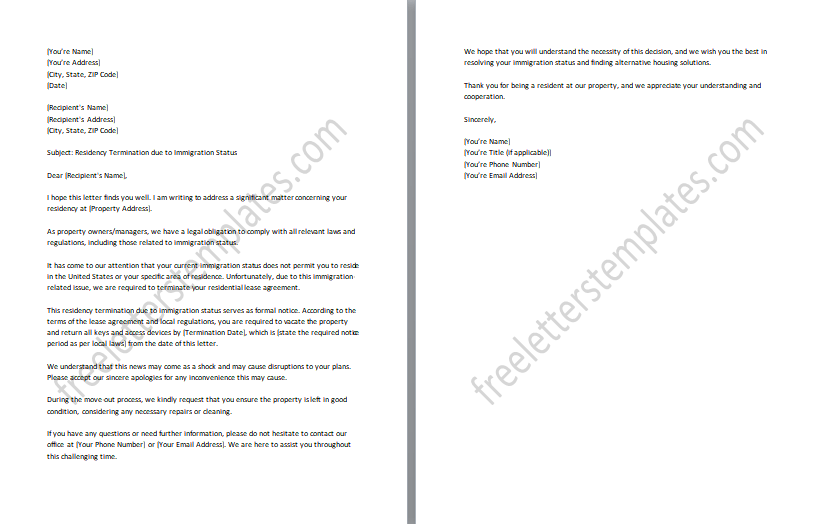
#24: Termination of Residency for Employment Relocation
The Termination of Residency for Employment Relocation is a letter landlords or property managers use to let tenants know that their lease agreement is ending because of the new job that requires them to move. It’s like saying, “Hey, your job is taking you somewhere else, and you gotta move too.” This letter is used when the tenant’s job demands relocation, and they need to leave their current place. The main idea is to be understanding during this time of change and give the tenant enough notice. We want to keep the communication clear about the tenancy ending and make sure the tenant has plenty of time to plan for moving out. The letter aims to maintain a good relationship between the landlord and the tenant while acknowledging the tenant’s career growth and the need for a smooth relocation process.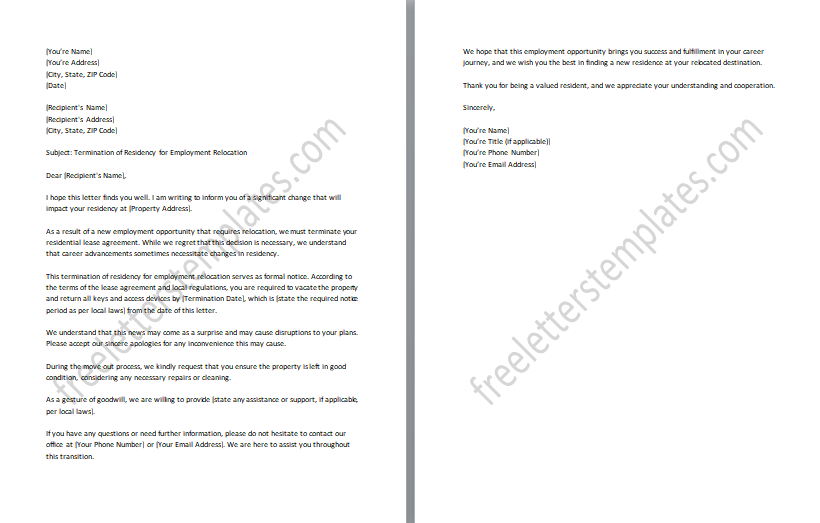
Customization
- Flexible Templates: Our termination letter templates are designed to be flexible and adaptable to various situations.
- Customize with Ease: Easily personalize the letters by adding tenant names, addresses, and specific details.
- Tailor to Your Needs: Tailor the letters to suit your unique circumstances and reasons for termination.
- User-Friendly Editing: With user-friendly editing options, customizing the templates is quick and hassle-free.
- Address Specific Violations: Add specific details to address lease violations or compliance issues accurately.
- Save Time and Effort: Save time drafting letters from scratch by using our customizable templates.
- Ensure Professionalism: Customizing the letters ensures a professional and personalized touch.
- Stay Compliant: Personalizing the templates helps you ensure compliance with local laws and regulations.
- Make an Impact: Personalized letters convey a sense of importance and care to tenants during the termination process.
Tips for a Lasting Home: Your Guide to Avoiding Termination
We understand that having a secure and comfortable place to call home is essential for everyone. To help you keep your tenancy on track and avoid any unwanted terminations, we’ve put together some attractive and easy-to-follow tips:
- Be a Rule Follower, Not a Rule Breaker: Review and understand your lease agreement thoroughly. Comply with all rules and regulations outlined in the lease to avoid any misunderstandings.
- Communication is Key: Keep the lines of communication open with your landlord or property manager. If you have any concerns or questions, don’t hesitate to reach out to them promptly.
- Timely Rent Payments: Pay your rent on time each month. Setting up automatic payments or reminders can be a great way to stay on top of this crucial responsibility.
- Treat It Like Your Own: Respect and take care of the property as if it were your own. Regularly perform routine maintenance and promptly report any issues to the landlord.
- Noise Control: Be considerate of your neighbors and keep noise levels in check. A harmonious living environment benefits everyone.
- Seek Permission: If you plan to make any alterations to the property, seek permission from your landlord first. Unauthorized changes can lead to complications.
- Keep It Clean: Maintain cleanliness in both your living space and common areas. A clean living environment is not only more pleasant but also shows your respect for the property.
- Report Issues Promptly: Report any maintenance or repair issues promptly to the landlord. Addressing problems early can prevent them from becoming more significant concerns.
- Cooperate During Inspections: Be cooperative during routine property inspections. It’s an opportunity for the landlord to ensure the property is well-maintained and to address any issues.
- Follow Move-Out Procedures: If you plan to move out, review the move-out procedures in your lease. Follow them closely to ensure a smooth and hassle-free transition.
Empowering Users with Knowledge
Knowledge is power, and we believe in empowering our users with comprehensive information on the termination process. That’s why we’ve gathered a collection of valuable resources to help you gain a deeper understanding of tenant-landlord rights, legal guidelines, and tenancy laws.
- Legal Guidelines and Regulations: Stay informed about the legal aspects of termination with links to official legal guidelines and regulations. Understand the proper procedures, notice periods, and requirements to ensure compliance with the law.
- Tenancy Laws by Region: We know that tenancy laws can vary by region, so we’ve curated links to tenancy laws specific to different areas. Explore the regulations in your location to ensure you’re well informed about your rights and responsibilities.
- Know Your Tenant Rights: Knowledge of your tenant rights is essential in any tenancy. Access resources that outline tenant rights, protection against wrongful eviction, and ways to assert your rights as a tenant.
Navigating the Termination Process
We understand that the termination process can be overwhelming, which is why we’ve created a resource section to guide you through this delicate phase.
- Step-by-Step Termination Guide: Follow our step-by-step termination guide that simplifies the process, highlighting what you need to do as a tenant to ensure a smooth termination or protect your rights.
- Understanding Termination Notices: Learn about the different types of termination notices and what they mean for you as a tenant. Familiarize yourself with the contents of each notice to be better prepared for any situation.
- Expert Advice and Tips: Our resources section includes expert advice and tips from experienced professionals in the industry. Benefit from their insights to handle termination situations with confidence.
- FAQ Section: Find answers to commonly asked questions about the termination process in our comprehensive FAQ section. Get clarity on complex issues and concerns that may arise during the termination.
Concluding Thoughts
In conclusion, Residency Termination Letters is your go-to resource for professionally crafted and customizable termination letter templates. Our user-friendly platform aims to simplify the termination process for landlords, property managers, and tenants alike. With a wide range of letters covering various termination scenarios, we offer the flexibility to address unique situations while maintaining legal compliance. We believe in fostering clear and respectful communication during this sensitive time, promoting positive relationships between landlords and tenants. Additionally, our comprehensive resources section empowers users with essential knowledge, enabling them to navigate the termination process with confidence. At Residency Termination Letters, we strive to be your trusted partner in facilitating smooth and amicable terminations, ensuring a harmonious transition for all parties involved.